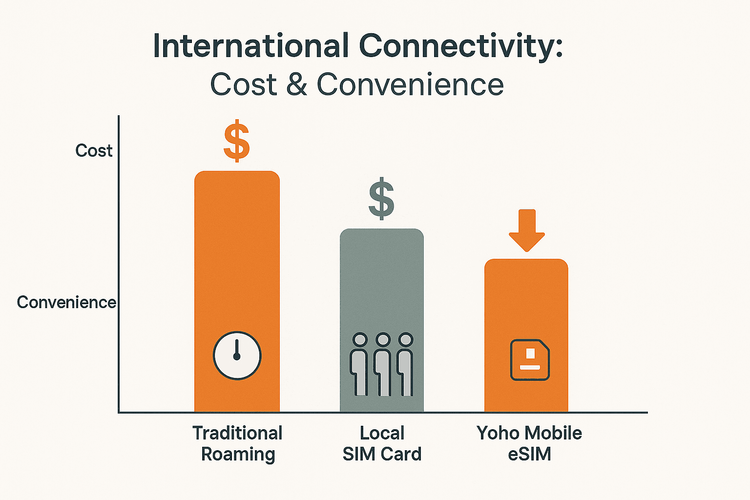Planning a big trip for 2026? The excitement is building. You’ve budgeted for flights and hotels, but what about the sneaky expenses lurking in the shadows? These unexpected travel expenses are the real budget-breakers, turning a dream vacation into a stressful experience.
The good news is that with a little foresight, you can outsmart these hidden costs. This guide will walk you through the seven most common budget traps and show you exactly how to avoid them. Ready to plan smarter? Start by securing affordable global data with a Yoho Mobile eSIM and say goodbye to your first hidden cost before you even pack.
1. Sneaky Foreign Transaction & ATM Fees
Using your everyday debit or credit card abroad can feel convenient until you see your statement. Many banks charge a foreign transaction fee, typically 1-3% of every purchase you make. Add to that the high fees for withdrawing cash from international ATMs, and these small charges can quickly amount to a significant sum.
How to Avoid Them: Before your trip, look for credit cards that waive foreign transaction fees—many travel-focused cards offer this perk. For cash, consider opening a bank account with a provider known for low or no international ATM withdrawal fees. A great resource for comparing cards is NerdWallet’s Best Travel Credit Cards list.
2. The Budget-Buster: Data Roaming Charges
Of all the unexpected travel expenses, “bill shock” from data roaming is one of the most notorious. Your home carrier might charge astronomical rates for using data abroad, and it’s easy to rack up a huge bill just by using maps or social media. Many travelers return home to a phone bill that costs more than their souvenirs.
This is where a modern connectivity solution shines. Instead of paying for expensive and limited roaming packages, an eSIM (embedded SIM) from Yoho Mobile gives you access to affordable, high-speed data in hundreds of destinations. You can buy and install your plan before you leave home. For iOS users, the process is incredibly simple—no QR codes needed, just a tap to install after purchase. Your phone just needs to be on the eSIM compatible devices list.

Whether you’re island hopping in Thailand or exploring the historic cities of Europe, you can select a plan that fits your exact needs. Customize your data plan for a trip to Europe and only pay for the data and duration you require. Plus, with Yoho Care, you have a data safety net, so you’re never truly disconnected, even if you use up your high-speed data.
3. The “Last Mile”: Local Transportation Costs
You’ve landed, but how do you get from the airport to your hotel, or from your hotel to the sights? Unplanned taxi rides, expensive ride-sharing surges, and single-journey transit tickets can drain your daily budget faster than you think.
How to Avoid Them: Research local transport options before you go. Many cities offer multi-day tourist passes that provide unlimited travel on buses, trams, and subways. Having a reliable data connection is crucial here. With an eSIM, you can use apps like Google Maps or Citymapper to navigate public transport networks like a pro, find the most efficient routes, and avoid costly taxi fares.

4. The Fine Print: Tourist Taxes & Resort Fees
That great hotel deal you found might not be as good as it seems. Many cities and resorts levy additional charges that aren’t included in the advertised price. These can include nightly tourist taxes, resort fees for amenities (whether you use them or not), and other local levies that are only payable upon checkout.
How to Avoid Them: Read the fine print before booking your accommodation. Most booking websites will mention these additional fees, though sometimes they are buried in the details. You can also check the official tourism website for your destination, such as the U.S. Department of State’s travel advisories, which often provide information on local laws and taxes.
5. The “Budget” Airline Trap: Baggage & Extra Fees
Budget airlines lure travelers with incredibly low base fares, but they make their money on ancillary fees. Checked baggage, carry-on bags that exceed specific dimensions, seat selection, and even printing a boarding pass at the airport can all come with hefty charges.
How to Avoid Them: Always read the airline’s baggage allowance and fee structure carefully before you book. Pack light to fit everything in a compliant carry-on, or pre-pay for your checked baggage online, which is almost always cheaper than paying at the airport.
6. Tipping Etiquette Traps
Tipping culture varies dramatically around the world. In the United States, a 15-20% tip is standard in restaurants, while in Japan, tipping can be considered rude. Getting it wrong can lead to awkward situations or accidentally overspending on every meal.
How to Avoid Them: Do a quick search for the tipping customs of your destination before you go. Authoritative travel guides, like those from Condé Nast Traveler, provide excellent country-by-country breakdowns. A few minutes of research can save you both money and embarrassment.
7. Before You Even Leave: Pre-Travel Expenses
Some of the most significant hidden costs occur before your trip even begins. These include visa application fees, necessary vaccinations, travel insurance, and buying travel-specific gear like power adapters or new luggage.
How to Avoid Them: Factor these costs into your initial travel budget. Don’t treat them as an afterthought. Apply for visas well in advance to avoid expensive expediting fees, and shop around for travel insurance to find a policy that offers the best value for your needs.
Frequently Asked Questions (FAQ)
Q1: What is the most overlooked travel expense?
While all the points above are commonly overlooked, exorbitant data roaming charges and local transportation costs are often the biggest culprits for busting a daily budget. Travelers often underestimate how much they’ll rely on their phones for maps and information, leading to high bills, and they fail to research cost-effective public transport, resulting in expensive taxi rides.
Q2: How can I save money on mobile data while traveling internationally in 2026?
The easiest and most effective way is to use a travel eSIM. A provider like Yoho Mobile offers flexible, prepaid data plans that you can install before you leave. This gives you high-speed data at a fraction of the cost of roaming and is far more convenient than hunting for a local SIM card upon arrival. You can even try it before you commit with a free eSIM trial.
Q3: What are the biggest hidden costs of travel besides flights?
After flights and accommodation, the biggest hidden costs are often a combination of data roaming fees, food and drink (especially in tourist-heavy areas), local transportation, and activity or entrance fees that weren’t budgeted for in advance. Planning your connectivity and daily transit are two of the most impactful ways to keep these costs under control.
Conclusion
Your 2026 travel adventure should be about making memories, not stressing over money. By being aware of these seven hidden costs, you can create a more realistic and resilient travel budget. Proactive planning is your best defense against unexpected travel expenses, from choosing the right credit card to pre-booking your baggage.
Don’t let hidden costs spoil your trip. Take control of your budget, starting with the easiest expense to manage: your phone bill. Explore Yoho Mobile’s affordable eSIM plans today!
